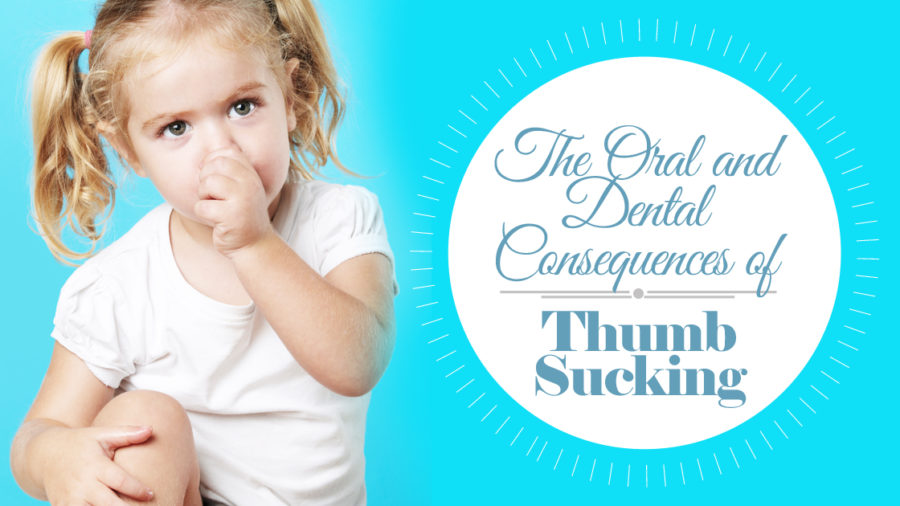Thumb sucking can be a regular source of both comfort and stress for both children and parents. Thumb or finger sucking, or the use of a pacifier can help children learn to self-soothe, which is an important coping mechanism and developmental ability. There are an endless number of self-proclaimed experts on both, many of whom are happy to provide parents with free advice at the park or grocery store!
When it comes to thumb sucking, can kids have too much of a good thing? Self-soothing is an important skill for children to learn, but thumb sucking or using a pacifier for too long can have an impact on the development of your child’s jaw and soft palate.
What Kinds of Problems Might My Child Experience Due To Prolonged Thumb-Sucking?
Some of the common effects dentists and orthodontists see from such habits are: bone or teeth positions in a reverse relationship on back teeth (called a crossbite), an opening in the front bite due to pressure on the teeth which prevents them from growing down into their proper positions, or flared front teeth which “stick out” (called overjet) and often also results in larger spaces between teeth. These types of problems may require orthodontic treatment in the future to help achieve a proper bite and improve the how your child’s teeth appear and fit together.
Some children may need early treatment during the elementary school years, and may require more than one phase of orthodontic therapy to address issues with their bite. Children with protrusive teeth may also experience more damage to the teeth if they are involved in a traumatic fall or accident, which, at this age, is relatively common during regular play or group sporting activities.
How Can I Stop My Child’s Thumb-Sucking?
Each child’s orthodontic needs are determined by both biological or genetic factors, as well as environmental factors. Certain environmental factors, such as thumb sucking, can be controlled, and as orthodontists, we believe it is best to do so to avoid potential problems.
Many children stop using a pacifier or sucking their thumb or fingers on their own. Pacifier use is somewhat easier to stop, because we can keep that away from children, and use other methods to self-soothe. There are a variety of techniques and methods to help children to stop sucking their thumbs, many of which depend upon the child’s developmental age and abilities.
Very young children may not be able to understand or reason with the idea of stopping the habit. For older children persisting with the habit, they must consciously want to stop the habit for it to come successfully to an end. There are several psychological factors to consider and each child may need a different approach.
Positive reinforcement is often an effective first step, with rewards systems to help reinforce the behavior you want to see. It may also be possible to replace the fingers with another object used to soothe or comfort, such as a blanket, or stuffed animal for younger children.
In some cases, it may be beneficial to engage the expertise and support of a behavioral therapist or myofunctional therapist. These experts in child development have programs which engage the children to help them with habit cessation, and help parents to reinforce these changes at home over time.
Other approaches, which may be combined with positive reinforcement or therapy, can include the use of more restrictive methods such as bitter tasting nail polish, special shirts designed without arm sleeves for nighttime wear, thumb guards which wrap around the thumb like a splint or brace, or in severe cases an oral appliance designed to restrict the thumb sucking habit and act as a reminder for the child.
At What Age Should I Worry If My Child Still Wants to Suck Their Thumb?
The American Academy of Pediatric Dentistry suggests that children should eliminate sucking habits by 36 months (3 years) of age, if not sooner. Creating healthy habits for children is a lifelong activity and the best way to prevent issues is to address them early on. The American Academy of Pediatric Dentistry recommends bringing your child for their first dental check-up at age 1, even if your child does not yet have teeth. Regular six-month check-ups help to establish great habits, as well as allow your child’s dentist to observe growth and development, and discuss any findings they may observe with you.
Whenever you have concerns about your child’s jaw and soft palate development, we encourage you to seek the support of an orthodontist or pediatric dentist. The dentist or orthodontist will assess the child’s behavior and evaluate the child’s bite to provide guidance and suggestions on cessation approaches that can help. The American Association of Orthodontists recommends that every child should have an orthodontic evaluation by age 7.



Leave a Reply
Your email is safe with us.